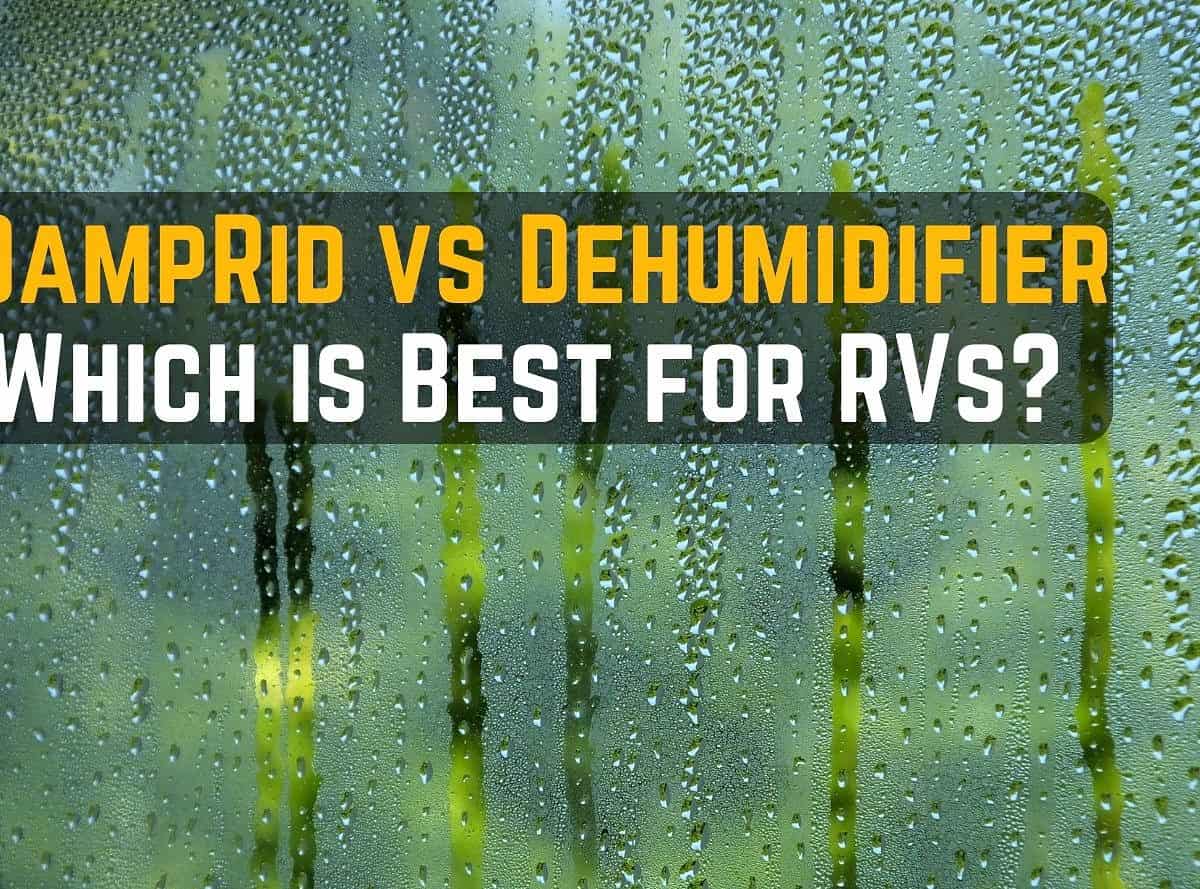Humidity and moisture are a problem for RVers in every season. In the winter, humidity creates damaging condensation. And in the summer, humidity makes your RV feel stuffy and hot. There are a few options to combat moisture in your RV, and a lot of RVers are divided on the subject of DampRid vs dehumidifier.
So what’s the best option: DampRid vs a dehumidifier? The real answer is a dehumidifier – it works immediately to pull moisture out of the air in the open spaces of your RV. However, DampRid can be helpful to remove moisture from your RV cabinets and closets.
There is some nuance to that answer and more to learn about each option. Let’s take a closer look.
This post contains affiliate links.
Table of Contents
DampRid vs Dehumidifer: What’s The Difference?
The main difference between DampRid and dehumidifiers is that DampRid is a chemical solution that slowly removes moisture from small enclosed spaces, like closets. Dehumidifiers are electric appliances that immediately remove moisture from the air in an open space, like an RV or room in a house. Let’s take a closer look at each option.
What DampRid is and How it Works

DampRid is a product that’s made of inorganic calcium chloride crystals. These crystals draw moisture out of the air. As they do so, the crystals liquify and the result is a brine of what the manufacturer describes as ‘saltwater’, but it’s not the regular table or sea salt we’re used to. It’s a chemical solution.
DampRid does not fully remove moisture from a room–it merely displaces it until you remove it yourself. And due to it’s limited size and the slow process of turning the crystals into brine, it’s not an immediate solution. It’s also not a robust or long-term solution.
The manufacturer website says:
“DampRid crystals work immediately to remove excess moisture from the air. The crystals harden and form a solid mass. Then they begin to dissolve and liquid will begin to drip into the bottom chamber. It may take a few days before liquid begins to drip.” – DampRid.com
They state it works “immediately” but then they say that it “may take a few days”… Things that make you go “hmmmm“.
What Dehumidifiers Are and How They Work
A dehumidifier is an electric appliance that uses electricity to pull air in from the room with a fan. It then passes the air over refrigerated coils inside the machine which cause the water vapor in the air to create condensation on the coils, which drips into a holding tray. Then, the fan blows the now-dry air back into the room.
Dehumidifiers work immediately – as soon as you plug it in and turn it on. Once the tray is full, you can dump it outside or down the drain. This water is not potable.
Dehumidifiers come in different sizes and can hold varying amounts of water in the tray.
What’s Better for Moisture in an RV: DampRid or a Dehumidifier?
The best solution for removing moisture and humidity in an RV is a dehumidifier, hands down.
But DampRid can also be useful in small enclosed spaces like cabinets and closets.
A dehumidifier works immediately – as soon as it’s plugged in. It goes to work circulating the air in your camper and pulling the water vapor from the air on it’s refrigerated coils. Instead of the condensation forming in your camper, it forms inside the dehumidifier and drips into a tray for easy removal.
Dehumidifiers do not use any exposed chemical compounds to remove moisture from the air. And even if you spill the water from the tray, there are no chemicals in it. It’s just water from the air–but that doesn’t mean it’s safe to drink or clean with. But it won’t stain your floor or poison kids or pets!
Here are the best uses for DampRid vs dehumidifiers.
| DampRid Best Uses | Dehumidifier Best Uses |
|---|---|
| Closets | Living Areas |
| Cabinets | Bedrooms |
| Storage Bays | Kitchens |
| Small, enclosed spaces w/no airflow | Open spaces with airflow |
| Areas without traffic from kids and pets | Any area with any traffic |
- Efficient Dehumidification: This dehumidifier has a 68oz water tank and can remove 34oz of moisture from the air per day.
- Easy Empty: Comes with a drain hose for easy emptying into a sink, tub, or bucket. Also has removable tank.
- Auto Shut Off: Auto shut off feature prevents overflow of water tank.
- Made for Portability: Has a handle to easily move the dehumidifer to different areas of your RV for the best dehumidification.
- Great for Any Season: Helps remove moisture in RV during the winter and helps remove humidity in summer so your AC can work more efficiently.
Why DampRid Alone is Not Enough to Battle RV Moisture and Condensation
If you’re wondering “Does DampRid work in an RV?” The answer is: kinda. DampRid uses a chemical crystal solution to remove small amounts of moisture in the air in enclosed spaces, like cabinets and closets. But it works very slowly and stops working when the crystals are gone.
DampRid does not work indefinitely, and it’s not enough for an RV… especially in the winter! Moisture, humidity, and condensation is a constant battle for RV owners. And it’s worse in the winter time, because most RVs have propane furnaces. If you live in an RV in the winter, you are likely using your furnace a lot. When propane burns (like as a heat source), it releases even more water vapor in the air.
For every gallon of propane used by an RV furnace, stove, or water heater, 1.6 gallons of moisture (water vapor) is released into the air.
(Source 1) (Source 2)
The truth is: DampRid containers just aren’t enough! With this kind of moisture entering the air in your RV, you need an immediate solution that works constantly, like a dehumidifier.
Related: 5 DIY RV Skirting Ideas for Winter
Why Moisture and Humidity Is Bad in an RV

You might be wondering why humidity in an RV is even a big deal – especially in the winter! In sticks and bricks houses, most people need a humidifier in the wintertime, not a DE-humidifier.
Humidity and moisture are a problem in RVs and campers because they cause condensation to form on the walls and windows which can lead to mold and water damage. Excess condensation drips down into the flooring and walls creating mold, mildew, and if left untreated, they will create water damage.
But before damage to the wood occurs, the moisture from the humidity in the air will cause mold and mildew to grow–this can be a major health issue for humans and pets both.
Related: How Much Snow Can an RV Roof Hold?
What Causes Humidity and Condensation in a Camper?
When warm, humid air meets cold surfaces like walls, floors, and windows, condensation forms.
In fact, that’s exactly how dehumidifiers work: they pull in warm, moist air from the room and pass them over cold coils to create condensation that drips into a tray to be dumped.
There are many things that create humidity in your camper or RV, like:
- Water vapor from breathing
- Water vapor from cooking food
- The water released into the air from a propane stove, furnace, and water heater (1.6 gallons of moisture is released for every gallon of propane burned)
- Showers
- Laundry
- Dishwashers
Additionally, if the local environment is humid, the air inside your RV will also be humid.
And if it’s cold outside, condensation starts to form everywhere. Even on the bottom side of your mattress–this is a common spot for moisture and mold growth in an RV!
If you want a heat source that doesn’t produce water vapor, you should consider using a diesel heater in your RV. Diesel heaters produce a dry heat and are more energy and fuel efficient than propane heat sources.
Pro tip: products like the Froli Sleep System are designed to increase air flow under your mattress to prevent mold growth.
What Is the Best Way to Remove Moisture From An RV Camper?
The best way to remove moisture from an RV is with a dehumidifier. But, there are other things you can do to help prevent adding more moisture to the air in the first place!
- Use your vent fan when cooking, showering, and using a dishwasher.
- Cook outside, weather permitting.
- Don’t hang wet things to dry inside the camper.
- If possible, use a campground shower instead of your RV shower.
- Insulate your RV, especially in colder areas like RV slide outs, windows, etc.
Wrapping Up: DampRid vs Dehumidifiers for RVers
Dehumidifiers are best for RVers who are serious about moisture control, but DampRid is still helpful in small spaces like closets or cabinets.
Exercise caution when using DampRid around children or pets, and consider using a waterproof mat below in case of any spills or leaks.



